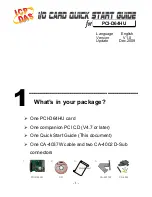
370 Appendix
WAGO-I/O-SYSTEM 750
750-8207 PFC200 CS 2ETH RS 3G
Manual
Draft version 1.2.1 from 2017-09-13, valid from FW Version 02.06.20(09)
15.1.5.17 Vibration Velocity/Bearing Condition Monitoring VIB I/O
750-645
The Vibration Velocity/Bearing Condition Monitoring VIB I/O has a total of 12
bytes of user data in both the Input and Output Process Image (8 bytes of
module data and 4 bytes of control/status). The following table illustrates the
Input and Output Process Image, which have 8 words mapped into each image.
Word alignment is applied.
Table 288: Vibration Velocity/Bearing Condition Monitoring VIB I/O 750-645
Input and Output Process Image
Offset
Byte Destination
Description
High Byte
Low Byte
0
-
C0/S0
not used
Control/status byte
(log. Channel 1,
Sensor input 1)
1
D1
D0
Data bytes
(log. Channel 1, Sensor input 1)
2
-
C1/S1
not used
Control/status byte
(log. Channel 2,
Sensor input 2)
3
D3
D2
Data bytes
(log. Channel 2, Sensor input 2)
4
-
C2/S2
not used
Control/status byte
(log. Channel 3,
Sensor input 1)
5
D5
D4
Data bytes
(log. Channel 3, Sensor input 3)
6
-
C3/S3
not used
Control/status byte
(log. Channel 4,
Sensor input 2)
7
D7
D6
Data bytes
(log. Channel 4, Sensor input 2)
15.1.5.18 KNX/EIB/TP1 Module
753-646
The KNX/TP1 module appears in router and device mode with a total of 24-byte
user data within the input and output area of the process image, 20 data bytes
and 2 control/status bytes. Even though the additional bytes S1 or C1 are
transferred as data bytes, they are used as extended status and control bytes.
The opcode is used for the read/write command of data and the triggering of
specific functions of the KNX/EIB/TP1 module. Word-alignment is used to assign
12 words in the process image. Access to the process image is not possible in
router mode. Telegrams can only be tunneled.
In device mode, access to the KNX data can only be performed via special
function blocks of the IEC application. Configuration using the ETS engineering
tool software is required for KNX.
















































